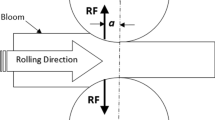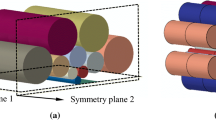Abstract
SAE 1541 grade steel bars are widely used in automobile sector, mining, ship** and forging industry due to their affordability and adaptability. Steel industries have been striving for productivity and better yield of hot-rolled bar products. The roll separating force, driving torque, end crop length and drive energy are the important response parameters to be controlled for quality production, maximization of yield, safety of mill and reduction in energy consumption. These response parameters depend on several process parameters–rolling speed, billet temperature, reduction ratio, billet cross-sectional area, roll diameter. This paper presents a study on the effect of the process parameters on the response parameters during rolling of SAE 1541 steel. Simulation of the rolling process has been attempted using FORGE® NxT 1.1. The simulated results so obtained have been validated through experimental results obtained in a rolling mill, following statistical tests. Regression models showing relationship between the process parameters and the response parameters have been developed. Significant model terms have been obtained using ANOVA. The optimum rolling conditions for minimization of the response parameters have been obtained.














Similar content being viewed by others
References
M. Bagheripoor and H. Bisadi, Application of Artificial Neural Networks for the Prediction of roll Force and Roll Torque in Hot Strip Rolling Process, App. Math. Model., 2013, 37, p 4593–4607.
M. Bagheripoor and H. Bisadi, An Investigation on the Roll Force and Torque Fluctuations During Hot Strip Rolling Process, Prod. Mfg. Res., 2014, 2(1), p 128–141.
L.S. Bayoumi and Y. Lee, Effect of Inter-Stand Tension on Roll Load, Torque and Work Piece Deformation in the Rod Rolling Process, J. Mat. P. Tech., 145: 7–13 (2004)
T.E. Bitar, M.E. Meligy and E. Shenawy E, Prediction of roll separating force in a roll pass design of micro-alloyed steel rods, WIT Transact. Built. Envi., 2014, 137, p 67–79.
S.M. Byon, Numerical and Experimental Approach to Investigate Plane-view Shape and Crop Loss in Multistage Plate Rolling, K. Soc. Mech. Eng., 2013, 37(9), p 1117–1125.
W. Chan, A. Wang, and J.M. Shoup, Real Time Torque Measurement of Rolling Mill Drive, IEEE. 0-7803-5589-X/99: 557-564 (1999)
M.S. Chun and Y.H. Moon, Optimization of the Amount of Edging to Increase Rolling Yields in a Plate Mill, J. Mat. P. Tech. 104, 11–16 (2000)
A. Grajcar, Researches and Simulations in Steel Rolling, Metals, 2021, 11, p 560.
U. Hanoglu and B. Sarler, Multi-Pass Hot-Rolling Simulation Using a Mesh Less Method, Comp. Strs., 2018, 194, p 1–14.
S.M. Hwang and S. Kobayashi, Preform Design in Plane-Strain Rolling by the Finite-Element Method, Int. J. Mach. Tool Des. Res., 1984, 24(4), p 253–266.
L.E. Klosterman, R.T. Richter, M.D. Crowley, and A. Maslanka (2002). Method for Reducing Crop Losses during ingot rolling, US Patent No. 6453712 B1.
W.J. Kwak, Y.H. Kim, J.H. Lee and S.M. Hwang, A Precision On-Line Model for the Prediction of Roll Force and Roll Power in Hot-Strip Rolling, Met. Mat. Trans., 2002, 33A, p 3255.
H.B. Lim, H.I. Yang and C.W. Kim, Analysis of the Roll Hunting Force Due to Hardness in a Hot Rolling Process, J. Mech. Sci. Tech., 2019, 33(8), p 3783–3793.
M.K. Majumder, P.R. More, S. Chatterjee, P.S. Mandley and S.K. Pal, Roll Separating force in Hot Rolling Under Grooved Rolls–a Finite Element Analysis and Experimental Validation, Ind. J. Engg. Mat. Sci., 2016, 23, p 267–273.
C.H. Moon and Y. Lee, An Approximate Model for Local Strain Variation Over Material Thickness and its Applications to Thick Plate Rolling Process, ISIJ Int., 2009, 49(3), p 402–407.
K. Mori, K. Osakada and T. Oda, Simulation of Plane-Strain Rolling by the Rigid-Plastic Finite Element Method, Int. J. Mech. Sci., 1982, 24(9), p 519–527.
R.S. Nalawade, V.R. Marje, G. Balachandran and V. Balasubramanian, Effect of Pass Schedule and Groove Design on the Metal Deformation of 38MnVS6 in the Initial Passes of Hot Rolling, Sadhana, 2016, 41(1), p 111–124.
R.S. Nalawade, K.N. Mahadik, V. Balasubramanian, R.K. Singh, V. Satish, K. Cheekatla and P.P. Date, A Novel Method to Reduce End Crop Loss in Rolled Bars, Steel Tech., 2012, 6(4), p 57–66.
A.R. Ragab and S.N. Samy, Evaluation of Estimates of Roll Separating Force in Bar Rolling, Transaction of the ASME, J. Mfg. Sci. Engg., 2006, 128, p 34–45.
S. Rath, Computer Simulation of Hot Rolling of Flat Products, Soft. Engg., 2016, 4(6), p 75–81.
N.A. Razani, B.M. Dariani and M. Soltanpour, Microstructure and Mechanical Property Improvement of X70 in Asymmetrical Thermo-Mechanical Rolling, Int. J. Adv. Mfg. Tech., 2018, 97, p 3981–3997.
R. Rentsch and C. Prinz (2012). Finite element analysis of the hot rolling process on the origins of in homogeneities related to steel bar distortion, Mat.-wiss. u.Werkstofftech. 43:1–2.
A. Said, J.G. Lenard, A.R. Ragab, and M.A. Elkhier, The Temperature, Roll Force and Roll Torque During Hot Bar Rolling, J. Mat. P. Tech., 88: 147–153 (1999)
A. Samuel and K.N. Prabhu, Residual Stress and Distortion during Quench Hardening of Steels: A Review. J. Mater. Eng. Perform. 1–28 (2022)
S. Sarwito and S.A. Semin, Analysis of Three Phases Asynchronous Slip Ring Motor Performance Feedback Type 243, Int. J. Marine Eng Inn. Res., 2017, 2, p 1–7.
G. Singh, P.K. Singh, Effect of process parameters on roll separating force driving torque and end crop length during grooved hot rolling of SAE 1020 steel, J. Mfg. P. 79, 1003–1016 (2022)
G. Singh and P. K. Singh, Effect of process parameters on performance of grooved hot rolling of SAE 4340 steel bars. Mater. Manuf. Process., 1–14 (2022).
U. Stahlberg and A. Goransson, Heavy Reductions by Means of “Non-Bite” Rolling, Including Some Observations on Work Piece Shape, J. of Mech. Working Tech., 1986, 12, p 373–384.
U. Stahlberg, J.O. Soderberg and A. Wallero, Overlap at the Back and Front End in Slab Ingot Rolling, Int. J. Mech. Sci., 1981, 23, p 243–252.
X. Wang, K. Chandrashekhara, S.A. Rummel, S. Lekakh, D.C. Van Aken and R.J. O’Malley, Modeling of Mass Flow Behavior of Hot Rolled Low Alloy Steel Based on Combined Johnson-Cook and Zerilli-Armstrong Model, J. Mater. Sci., 2017, 52, p 2800–2815.
F. Weidlich, A.P.V. Braga, L.G.D.B. da Slilva Lima, M.B. Junior and R.M. Souza, The influence of Rolling Mill Process Parameters on Roll Thermal Fatigue, Int. J. Adv. Mfg. Tech., 2019, 102, p 2159–2171.
Z. Wusatowski Fundamentals of Rolling 1st ed., Pergamon Press, pp. 25–150 (1969)
L.I. Xu, W. Hongyu, D. **gguo, X. Jiu**g and Z. Dianhua, Analysis and Prediction of Fishtail During V-H Hot Rolling Process, J. Cen. South Uni., 2015, 22, p 1184–1190.
S.H. Zhang, D.W. Zhao and C.R. Gao, The Calculation of Roll Torque and Roll Separating Force for Broadside Rolling by Stream Function Method, Int. J. of Mech. Sci., 2012, 57, p 74–78.
Acknowledgments
The authors are thankful to Mr. Raminderpal Singh (MD), Mr. S Paul (CEO), Mr. Ajay Jayale, (Plant Manager) and their entire team at Arora Iron & Steel Rolling Mills Pvt. Ltd. Ludhiana (India) for their support and motivation to carry out this work at their premises. Authors are also grateful to Dr. Sehijpal Singh, Professor, and the TEQIP Cell at Guru Nanak Dev Engineering College, Ludhiana (India), for their valuable suggestions and cooperation.
Author information
Authors and Affiliations
Corresponding author
Additional information
Publisher's Note
Springer Nature remains neutral with regard to jurisdictional claims in published maps and institutional affiliations.
Rights and permissions
Springer Nature or its licensor (e.g. a society or other partner) holds exclusive rights to this article under a publishing agreement with the author(s) or other rightsholder(s); author self-archiving of the accepted manuscript version of this article is solely governed by the terms of such publishing agreement and applicable law.
About this article
Cite this article
Singh, G., Singh, P.K. Modeling and Optimization of Process Parameters during Grooved Hot Rolling of SAE 1541 Steel. J. of Materi Eng and Perform 32, 10128–10140 (2023). https://doi.org/10.1007/s11665-023-07860-2
Received:
Revised:
Accepted:
Published:
Issue Date:
DOI: https://doi.org/10.1007/s11665-023-07860-2




